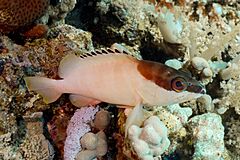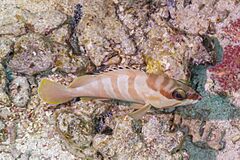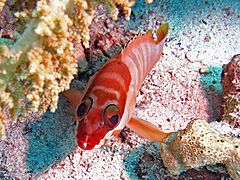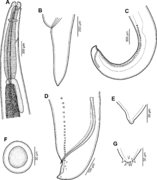Blacktip grouper facts for kids
Quick facts for kids Blacktip grouper |
|
|---|---|
 |
|
| Adult of Epinephelus fasciatus | |
| Conservation status | |
| Scientific classification | |
| Synonyms | |
|
The blacktip grouper (Epinephelus fasciatus) is a type of fish that lives in the ocean. It's also known by many other names, like the redbanded grouper or scarlet rock-cod. This fish belongs to a group called groupers, which are part of the family Serranidae. This family also includes sea basses. You can find blacktip groupers in the warm, tropical waters of the Indo-Pacific region.
Contents
What Does the Blacktip Grouper Look Like?
The blacktip grouper has a body that is about 2.8 to 3.3 times longer than it is deep. Its head is somewhat flat between the eyes. The top part of its head curves slightly.
Fins and Scales
This fish has a dorsal fin on its back with 11 strong spines and 15 to 17 soft rays. Its anal fin has 3 spines and 8 soft rays. The parts of the dorsal fin between the spines are deeply curved. The tail fin, called the caudal fin, is nicely rounded. Along its side, it has a lateral line with 49 to 75 scales.
Colors and Patterns
Blacktip groupers can be many different colors. They might be pale greenish-grey, light reddish-yellow, or even bright scarlet. Often, they have 5 or 6 faint dark stripes on their bodies. The last stripe is usually near the tail. The scales on the upper part of their body often have a light center and a dark edge. This creates a cool, checkered look.
The spiny part of the dorsal fin usually has a black outer edge. In some fish from Western Australia or deep waters, this edge might be dark red. There's also a small pale yellow or white spot behind the tip of each dorsal fin spine.
Size and Weight
Blacktip groupers can grow up to 40 centimetres (16 in) long. However, they are more commonly found at about 22 centimetres (8.7 in) in length. They can weigh up to 2.0 kilograms (4.4 lb).
Where Do Blacktip Groupers Live?
The blacktip grouper lives in a very large area across the Indo-Pacific. You can find them from the Red Sea all the way to the Eastern Cape in South Africa. They also live east towards the Pitcairn Islands, north to southern Japan and Korea, and south to New Caledonia and Australia.
Specific Locations
In the Indian Ocean, they are found near Madagascar, the Mascarenes, Comoros, and the Seychelles. In Australia, they live along the tropical coastlines. This includes places from the Houtman Abrolhos in Western Australia down to Port Hacking in New South Wales. They also inhabit reefs in the Coral Sea, Elizabeth Reef, around Lord Howe Island, and Christmas Island. In 2012, one was even seen in the eastern Mediterranean Sea, near Lebanon.
How Do Blacktip Groupers Live?
Blacktip groupers are clever hunters. They eat crustaceans (like crabs) and smaller fishes. They often hide and then suddenly attack their prey. This is called ambush hunting.
Habitat and Social Life
These fish usually live near coral reefs. You can find them in waters from 4 meters deep (though more often from 15 meters) down to 160 meters. They live in both ocean water and sometimes in brackish water, which is a mix of fresh and salt water. Sometimes, you might see them in groups of 10 to 15 fish. Young blacktip groupers, called juveniles, often hide in mangrove swamps for safety.
Fishing and Safety
People, like the Bedouin in the Red Sea, fish for blacktip groupers. However, sometimes eating this fish can cause a type of food poisoning called ciguatera.
Who Discovered the Blacktip Grouper?
The blacktip grouper was first officially described in 1775. It was named Perca fasciata by a Swedish-speaking Finnish explorer named Peter Forsskål. He found this fish near Ras Muhammad in Egypt.
Later, in 1793, a German naturalist named Marcus Elieser Bloch created a new group (genus) for fish like this, called Epinephelus. He described a fish he called E. marginalis. It turned out that E. marginalis was actually the same fish as Perca fasciata. This means the blacktip grouper is the main example, or "type species," for its entire genus.
Images for kids






